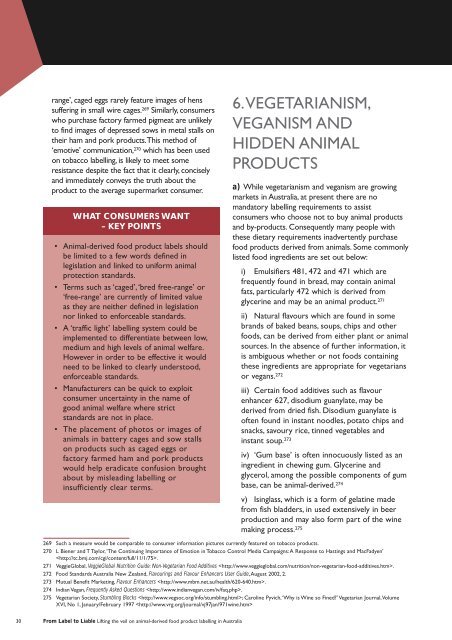From Label to Liable: Scams, Scandals and Secrecy - Voiceless
From Label to Liable: Scams, Scandals and Secrecy - Voiceless
From Label to Liable: Scams, Scandals and Secrecy - Voiceless
You also want an ePaper? Increase the reach of your titles
YUMPU automatically turns print PDFs into web optimized ePapers that Google loves.
ange’, caged eggs rarely feature images of hens<br />
suffering in small wire cages. 269 Similarly, consumers<br />
who purchase fac<strong>to</strong>ry farmed pigmeat are unlikely<br />
<strong>to</strong> find images of depressed sows in metal stalls on<br />
their ham <strong>and</strong> pork products. This method of<br />
‘emotive’ communication, 270 which has been used<br />
on <strong>to</strong>bacco labelling, is likely <strong>to</strong> meet some<br />
resistance despite the fact that it clearly, concisely<br />
<strong>and</strong> immediately conveys the truth about the<br />
product <strong>to</strong> the average supermarket consumer.<br />
WHAT CONSUMERS WANT<br />
– KEY POINTS<br />
• Animal-derived food product labels should<br />
be limited <strong>to</strong> a few words defined in<br />
legislation <strong>and</strong> linked <strong>to</strong> uniform animal<br />
protection st<strong>and</strong>ards.<br />
• Terms such as ‘caged’, ‘bred free-range’ or<br />
‘free-range’ are currently of limited value<br />
as they are neither defined in legislation<br />
nor linked <strong>to</strong> enforceable st<strong>and</strong>ards.<br />
• A ‘traffic light’ labelling system could be<br />
implemented <strong>to</strong> differentiate between low,<br />
medium <strong>and</strong> high levels of animal welfare.<br />
However in order <strong>to</strong> be effective it would<br />
need <strong>to</strong> be linked <strong>to</strong> clearly unders<strong>to</strong>od,<br />
enforceable st<strong>and</strong>ards.<br />
• Manufacturers can be quick <strong>to</strong> exploit<br />
consumer uncertainty in the name of<br />
good animal welfare where strict<br />
st<strong>and</strong>ards are not in place.<br />
• The placement of pho<strong>to</strong>s or images of<br />
animals in battery cages <strong>and</strong> sow stalls<br />
on products such as caged eggs or<br />
fac<strong>to</strong>ry farmed ham <strong>and</strong> pork products<br />
would help eradicate confusion brought<br />
about by misleading labelling or<br />
insufficiently clear terms.<br />
6. VEGETARIANISM,<br />
VEGANISM AND<br />
HIDDEN ANIMAL<br />
PRODUCTS<br />
a) While vegetarianism <strong>and</strong> veganism are growing<br />
markets in Australia, at present there are no<br />
m<strong>and</strong>a<strong>to</strong>ry labelling requirements <strong>to</strong> assist<br />
consumers who choose not <strong>to</strong> buy animal products<br />
<strong>and</strong> by-products. Consequently many people with<br />
these dietary requirements inadvertently purchase<br />
food products derived from animals. Some commonly<br />
listed food ingredients are set out below:<br />
i) Emulsifiers 481, 472 <strong>and</strong> 471 which are<br />
frequently found in bread, may contain animal<br />
fats, particularly 472 which is derived from<br />
glycerine <strong>and</strong> may be an animal product. 271<br />
ii) Natural flavours which are found in some<br />
br<strong>and</strong>s of baked beans, soups, chips <strong>and</strong> other<br />
foods, can be derived from either plant or animal<br />
sources. In the absence of further information, it<br />
is ambiguous whether or not foods containing<br />
these ingredients are appropriate for vegetarians<br />
or vegans. 272<br />
iii) Certain food additives such as flavour<br />
enhancer 627, disodium guanylate, may be<br />
derived from dried fish. Disodium guanylate is<br />
often found in instant noodles, pota<strong>to</strong> chips <strong>and</strong><br />
snacks, savoury rice, tinned vegetables <strong>and</strong><br />
instant soup. 273<br />
iv) ‘Gum base’ is often innocuously listed as an<br />
ingredient in chewing gum. Glycerine <strong>and</strong><br />
glycerol, among the possible components of gum<br />
base, can be animal-derived. 274<br />
v) Isinglass, which is a form of gelatine made<br />
from fish bladders, in used extensively in beer<br />
production <strong>and</strong> may also form part of the wine<br />
making process. 275<br />
269 Such a measure would be comparable <strong>to</strong> consumer information pictures currently featured on <strong>to</strong>bacco products.<br />
270 L Biener <strong>and</strong> T Taylor, ‘The Continuing Importance of Emotion in Tobacco Control Media Campaigns: A Response <strong>to</strong> Hastings <strong>and</strong> MacFadyen’<br />
.<br />
271 VeggieGlobal, VeggieGlobal Nutrition Guide: Non-Vegetarian Food Additives .<br />
272 Food St<strong>and</strong>ards Australia New Zeal<strong>and</strong>, Flavourings <strong>and</strong> Flavour Enhancers User Guide, August 2002, 2.<br />
273 Mutual Benefit Marketing, Flavour Enhancers .<br />
274 Indian Vegan, Frequently Asked Questions .<br />
275 Vegetarian Society, Stumbling Blocks ; Caroline Pyvich, ‘Why is Wine so Fined’ Vegetarian Journal, Volume<br />
XVI, No 1, January/February 1997 <br />
30<br />
<strong>From</strong> <strong>Label</strong> <strong>to</strong> <strong>Liable</strong> Lifting the veil on animal-derived food product labelling in Australia


